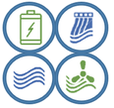Case Studies Conclusions
As stated, the purpose of the case studies was to demonstrate the robustness of the tool in its recommendations, attempting to identify a correlation between the HOMER modelling software output in the instance of Eigg, and a decision which reflected the strong, explicit tidal resource in the case of Islay. It can be confidently said that the tool performed well in both of these case studies, this is explained below in a concise reflection upon the output of both case studies.
Isle of Eigg
The overarching intention with regard to the Eigg based case study was to demonstrate the accuracy of the output of the tool, through the application of resource assessment and decision matrices, devices and location were selected and a levelised cost of energy established for each proposed option. As can be seen in the case study, there is a strong coalescence between the results. Overall:
- A HOMER model of the existing energy network was constructed to provide a baseline against which to measure performance.
- Varying magnitudes of marine resource were identified.
- A lack of viable tidal stream resource, consistent with tidal stream investigations from other parties, was identified.
- Technically feasible extraction methods for other marine resources and storage methods were identified.
- It was established that further expansion of the network would not be feasible with financial assistance.
Isle of Islay
The case study on Islay was intended to be significantly less in depth than that of Eigg and aimed purely at demonstrating the capability of the tool to highlight an explicit resource in a effort to prove its robustness. Given the final result was strongly in favour of exploitation of the tidal resource within the Sound of Islay, it would be fair to say that the tool performed as expected. Additionally, given the grid connection to the mainland, this also demonstrated the flexibility of the tool to recommend the use of various scales of device specific to individual situations, rather than simply be limited to recommending the least expensive device in relation to initial capital cost.
Finally, for this purpose, storage capability was ignored and the focus was solely on marine generation. Overall:
Finally, for this purpose, storage capability was ignored and the focus was solely on marine generation. Overall:
- Several areas of viable marine generation were identified.
- As expected, large generation devices were suggested.
- Andritz Hydro Hammerfest HS1000 device was returned as a recommendation, demonstrating a correlation between the advisory tool and actually feasible projects.
Project Conclusion
The main objectives of the project were met:
- A process to identify potential resource was developed.
- A tool which is capable of providing reasonable guidance on marine based generation and storage technologies was produced.
- Case studies were performed to demonstrate the capability of the advisory tool.
Further Work
Although several key objectives were met, there remains a scope for additional work in this area:
- Significantly expanding the database of technologies would allow for more comprehensive recommendations and remove an inherent bias towards scoring devices highly simply based on the completeness of their available data.
- An increased degree of complexity could be added to the process in order to recommend combinations of both generation and storage devices.
- Additional case studies could be performed to identify any pitfalls in the process and further refine the methodology.

